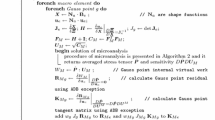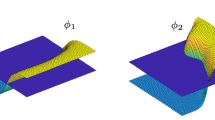Abstract
Beginning with augmentation of experimental boundary-data with numerical methods in early hybrid methods (HMs), HMs have evolved in various states of hybridization amalgamating combinations of theoretical, numerical and experimental analysis techniques. In this work, an HM coupling coarse-mesh FE boundary-data with a theoretical solution in the 2D elastostatic framework is proposed and explored. Utilizing Michell solution—a generalized Airy stress function in polar coordinate—the harmonic regression analysis carried out on the FEA hole-boundary displacement data renders coefficients embedded with Airy constants. These constants are determined from the equations furnished by imposing the boundary conditions strongly on the hole and by comparing the coefficients with the corresponding field variables. The method is illustrated for square and hexagonal perforated plates under symmetric, anti-symmetric and asymmetric loadings. von Mises stress calculated by the coarse-mesh based HM is corroborated with FEA employing a refined mesh. The results show good correspondence over a sizeable part of the domains, demonstrating the efficacy of the method. In addition, an extension of the HM incorporating experimental techniques to estimate remote-data from accessible boundary-data, the potential scope as a mesh-reduction technique and an alternative complex-variable formulation are discussed.





















Similar content being viewed by others
Abbreviations
- \(\phi \) :
-
Airy stress function
- \({\nabla ^4}\) :
-
Bi-harmonic operator
- \(r, \theta \) :
-
Polar coordinate
- \({\sigma _{rr}}, {\sigma _{\theta \theta }}, {\sigma _{r\theta }}\) :
-
Stress components in polar coordinate
- \({\varepsilon _{rr}}, {\varepsilon _{\theta \theta }}, {\gamma _{r\theta }}\) :
-
Strain components in polar coordinate
- \({u_{rr}}, {u_{\theta \theta } }\) :
-
Displacement components in polar coordinate
- \({\mathrm{{U}}_{\mathrm{{FEM}}}} ,{\mathrm{{U}}_{\mathrm{{HM}}}}\) :
-
Resultant displacements from FEM and HM respectively
- \(\nu \) :
-
Poisson’s ratio
- E :
-
Young’s modulus
- z :
-
Complex variable
- \(\gamma \), \(\psi \) :
-
Complex potentials
- \( \lambda \) :
-
Maximum normalized stress
- \(\mathrm {HM}\) :
-
Hybrid method
- \(\mathrm {FEA}\) :
-
Finite element analysis
- \(\mathrm {ASF}\) :
-
Airy stress function
- \(\mathrm {SIF}\) :
-
Stress intensity factor
- \(\mathrm {TSA}\) :
-
Thermoelastic stress analysis
- \(\mathrm {FDM}\) :
-
Finite difference method
- \(\mathrm {MLS}\) :
-
Moving least squares method
- \(\mathrm {PCM}\) :
-
Point collocation method
- \(\mathrm {BEM}\) :
-
Boundary element method
- \(\mathrm {WBM}\) :
-
Wave based method
- \(\mathrm {FEM}\) :
-
Finite element method
- \(\mathrm {SCF}\) :
-
Stress concentration factor
- \(\mathrm {BCs}\) :
-
Boundary conditions
References
Kobayashi SA (1983) Hybrid experimental–numerical stress analysis. Exp Mech 23(3):338–347
Atluri SN and Nishioka T. (1984) Hybrid methods of analysis. In: North-Holland Mathematics Studies, volume 94,. Elsevier, pp 65–95
Nishioka T, Atluri SN (1983) Analytical solution for embedded elliptical cracks, and finite element alternating method for elliptical surface cracks, subjected to arbitrary loadings. Eng Fract Mech 17(3):247–268
Nishioka T (1999) Hybrid numerical methods in static and dynamic fracture mechanics. Opt Lasers Eng 32(3):205–255
Lin SJ, Samad WA, Khaja AA, Rowlands RE (2015) Hybrid thermoelastic stress analysis. Exp Mech 55(4):653–665
Wen PH, Aliabadi MH (2012) A hybrid finite difference and moving least square method for elasticity problems. Eng Anal Bound Elem 36(4):600–605
Khaji N, Khodakarami MI (2011) A new semi-analytical method with diagonal coefficient matrices for potential problems. Eng Anal Bound Elem 35(6):845–854
Khaji N, Khodakarami MI (2012) A semi-analytical method with a system of decoupled ordinary differential equations for three-dimensional elastostatic problems. Int J Solids Struct 49(18):2528–2546
Maheri A, Noroozi S, Vinney J (2007) Combined analytical/FEA-based coupled aero structure simulation of a wind turbine with bend-twist adaptive blades. Renew Energy 32(6):916–930
Ma Y, Zhang Y, Wang BP (2017) A hybrid analytical and finite element method for mid-frequency vibration analysis of plate structures with discontinuities. Int J Struct Stab Dyn 17(04):1750052
Chen M, Zhang L, Xie K (2018) Vibration analysis of a cylindrical shell coupled with interior structures using a hybrid analytical–numerical approach. Ocean Eng 154:81–93
Louhghalam A, Takeru Igusa C, Park SC, Kim K (2011) Analysis of stress concentrations in plates with rectangular openings by a combined conformal mapping-finite element approach. Int J Solids Struct 48(13):1991–2004
Grm A, Batista M (2016) On the coupling of analytical and FEM solution in stress analysis around the polygonal hole shape in a finite two-dimensional domain. Int J Mech Sci 118:254–267
Batista M (2011) On the stress concentration around a hole in an infinite plate subject to a uniform load at infinity. Int J Mech Sci 53(4):254–261
Soutas-Little RW (2012) Elasticity. Courier Corporation, Chelmsford
Timoshenko SP, Goodier JN (1970) Theory of elasticity, 3rd edn. McGraw-Hill, New York
Barber JR (2002) Solid mechanics and its applications, elasticity. Kluwer, Dordrecht
Frocht MM (1941) Photoelasticity, vol 1. Wiley, Hoboken
Frocht MM (1948) Photoelasticity, vol 2. Wiley, Hoboken
Coker EG, Filon LNG, Jessop HT (1957) A treatise on photoelasticity. Cambridge University Press, Cambridge
Sadd HM (2009) Elasticity: theory, applications, and numerics. Academic Press, Cambridge
Saada SA (2009) Elasticity: theory and applications, revised and updated. J. Ross Publishing, Plantation
England AH (2003) Complex variable methods in elasticity. Dover, Mineola
Muskhelishvili NI (1977) Some basic problems of the mathematical theory of elasticity. Springer, Berlin
Isida M, Igawa H (1991) Analysis of a zig-zag array of circular holes in an infinite solid under uniaxial tension. Int J Solids Struct 27(7):849–864
Isida M, Igawa H (1991) Analysis of a zig-zag array of circular inclusions in a solid under uniaxial tension. Int J Solids Struct 27(12):1515–1535
Sih CG (2013) Methods of analysis and solutions of crack problems. Springer, Berlin
Pan Z, Cheng Y, Liu J (2013) Stress analysis of a finite plate with a rectangular hole subjected to uniaxial tension using modified stress functions. Int J Mech Sci 75:265–277
Sharma DS (2012) Stress distribution around polygonal holes. Int J Mech Sci 65(1):115–124
Jafari M, Ardalani E (2016) Stress concentration in finite metallic plates with regular holes. Int J Mech Sci 106:220–230
Acknowledgements
The authors would like to thank the anonymous reviewers for their valuable comments and suggestions
Author information
Authors and Affiliations
Corresponding author
Ethics declarations
Conflict of interest
The authors declare that they have no conflict of interest
Additional information
Publisher's Note
Springer Nature remains neutral with regard to jurisdictional claims in published maps and institutional affiliations.
Rights and permissions
About this article
Cite this article
Thube, Y.S., Lohit, S.K. & Gotkhindi, T.P. A coupled analytical–FE hybrid approach for elastostatics. Meccanica 55, 2235–2262 (2020). https://doi.org/10.1007/s11012-020-01254-7
Received:
Accepted:
Published:
Issue Date:
DOI: https://doi.org/10.1007/s11012-020-01254-7




